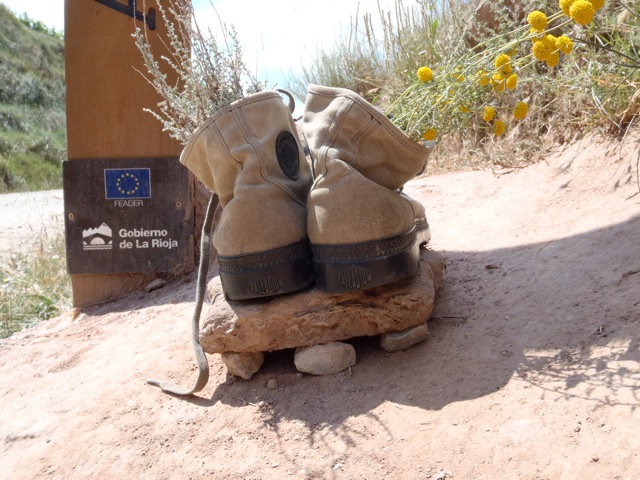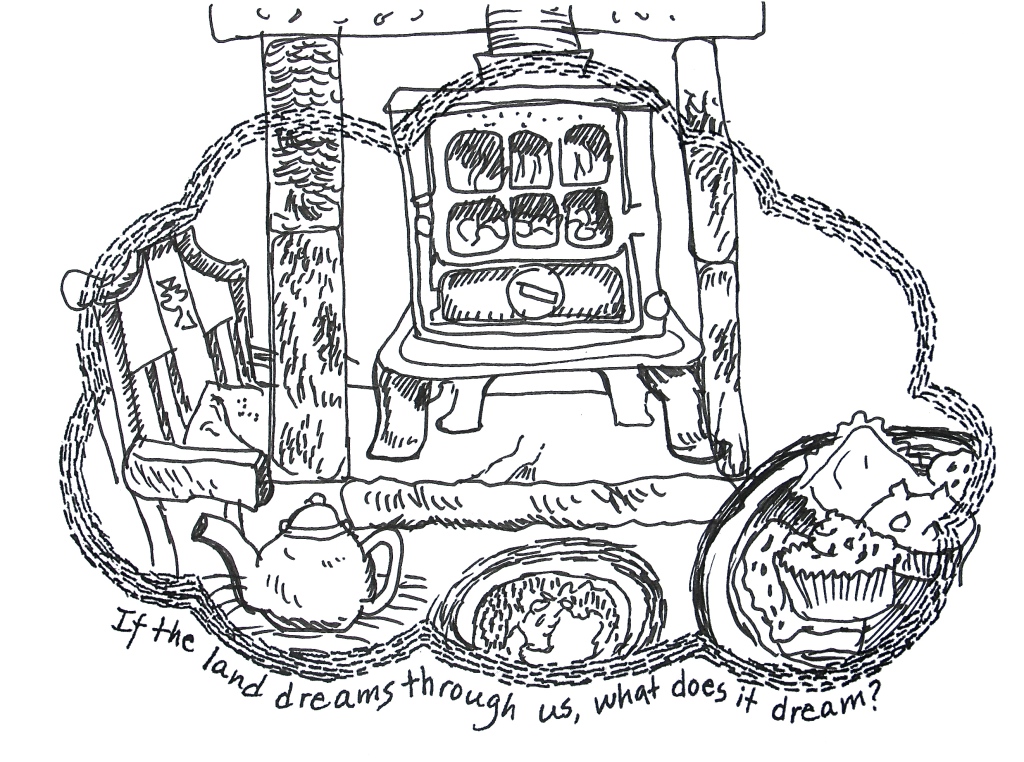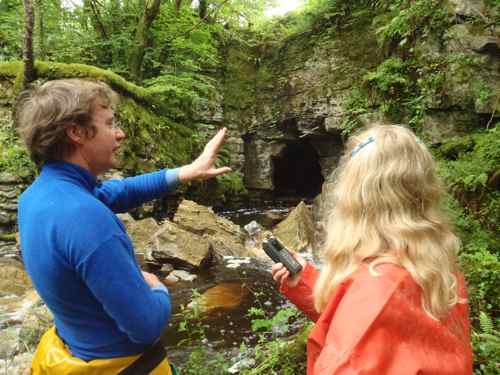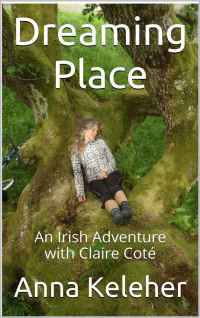“It’s 35 degrees Centigrade and the sky is black with thunder as we exit a bar in Villa Franca de Oca. We carry fresh “bocadillos” in our packs and hot mint tea and we’ll walk ’till dusk.
“I think we’re in for our first storm” I say.
” Maybe….” says Mark
Last night we had a wilderness experience off the beaten track; two sleepy sillouettes on a starry hilltop with a happy soundtrack of cowbells and frogs. And tonight we’ll sleep under a natural canopy in the Forest of “Oca” (Goose in Spanish).
” D’ya think we’re MAD? ” I say as we head off together, up a steep and stony path.
“Probably…” says Mark.
When we reach an interpretation panel by the wayside, we stop to have a look.
“Look” I say “There are Brown bears and ….. ” my eyes open wide and my eyebrows shoot up.
“and… Wolves….!!!!”
“Mmmm… ” says Mark
Back home in Devon my mum emailed me to say “Be careful of wolves on the forest tracks”
“What makes you think there are WOLVES? on the Camino? ” I tell her.
An almighty crack shatters the peace and tranquility of the Camino and the sky splinters into shards.
” A proper attack of aniseed balls” I say while the weather pummels our heads and necks as we run for the woods.
We cosy up under the tarp next to one massive deciduous oak.
“It’s almost fun” I say daring the storm.
We follow the trail upward and just as rain begins to fall, a perfect shelter pops up magically from the track. At the back of this welcome rain-shade is a lone pilgrim.
“I hope he doesn’t mind” says Mark as we head into dry-space.
“I’d do the Camino just for the VIEWS ?” says the sitting man bewitched by the panorama.
“I started out with my girlfriend” he tells us “but the Camino’s not for her”.
” Oh?” says Mark.
“Her pack was too heavy and she wasn’t enjoying it. She had to go back to work”
Our shelter companion for the duration of the rain is Paul Murphy.
” I’m an MEP” says Paul ,”for the Irish Socialist Party”. ” I’ve just lost my seat in Brussels so I’m out of a job in a week.”
We find we know nothing about members of the European parliament so Paul fills us in. “MEPs earn 90.000 Euro a year. ” he says. Now that’s a big incentive .
“As MEP’s we get 300 Euros per day every day we attend Parliament. Just for turning up”
” hmmm” says Mark.”Seems a lot”.
” But…..” says Paul “As a member of the Irish Socialist Party we pay ourselves the average national youth wage for Ireland.”
“The youth wage? I ask ” The YOUTH wage says Mark.
It’s still raining so Paul chats on. He’s signed in at a hostel for the night and has come out without his rain jacket . Luckily he has a lot of stories and is happy to share them with us. He is a persona non-grata in a couple of states. He was part of the flotilla taking supplies into Gaza, he was captured at gun point and ended up an Israeli jail, so he’s not very popular there.
“What was it liiiiike in Prison?” I ask my eyes popping.
“Oh” he says ” It was muuch better than the yacht.” ” I was so seasick, it was really horrible.”
We couldn’t have dreamed up a more humble and engaging pilgrim to be holed up with in the rain. And he has more stories.
“I helped broker a deal for striking miners in Kazakstahn” he tells us.
“You’re an activist” then?”
“Yes” says Paul “My party brokered an agreement between the government and the striking miners”
We smile expectant.
“But as soon as we left the country the miners were shot!”
We digest the news as rain drums on the roof above.
And before the rain ceases there is time to tell Paul about Claire and me about DREAMING PLACE and how we took Radio Dreaming back to play to Mary-Jane and other participants in Ireland in our Place-dreamer Pod and what a lot of effort went into the Kickstarter campaign.
” And did Mary-Jane get to hear Radio Dreaming at her homestead” says Paul.
” Yes she did!” in his mind’s eye an old lady is a-listening in the Pod, her eyes alight with dreams.
Our rainy meeting in the pop-up shelter on The Camino has conjoured up diverse visons. And now it’s time for Paul to head back down to his hostel for the night.
“What time are you up in the morning” he asks us as he gets up to go.
“Oh about 7.30 or 8.00 a.m”
Though the storm has moved away we decide to stay the night in the shelter. Its just too good to miss. So we eat our bocadillos, drink the lovely hot tea and lay our bags out for the night in this Camino dreaming place.
“D’you think the bins’ll lure in hungry wolves “I say.
“Yup says Mark.
Now he puts on his wooly hat.
“Buenas Noches” he says and he’s asleep.
In the morning we set off along a steaming trail into the big woods.
“Red riding hood would have been safe here ” I say, for the mystery of the wood is lost on the grit causeway the Camino has become.We gravitate to a pilgrim friendly ditch by the side of the Super-Camino where we walk in single file.
“I passed by for you at seven thirty ” says a voice from trail “but you’d already gone!”
“We had the Mother of all Storms in the night.” calls up Mark cheerily from inside the ditch.
This blogstory is one of several by Anna is writing about her journey with Mark on the Camino de Santiago Pilgrim Trail in Northern Spain.
Paul Murphy is AAA (Anti- Austerity – Alliance) Member of Parliament for Dublin South West. Paul’s website.
Find out about Paul’s popular AAA campaign to scrap water charges in Ireland .










































































